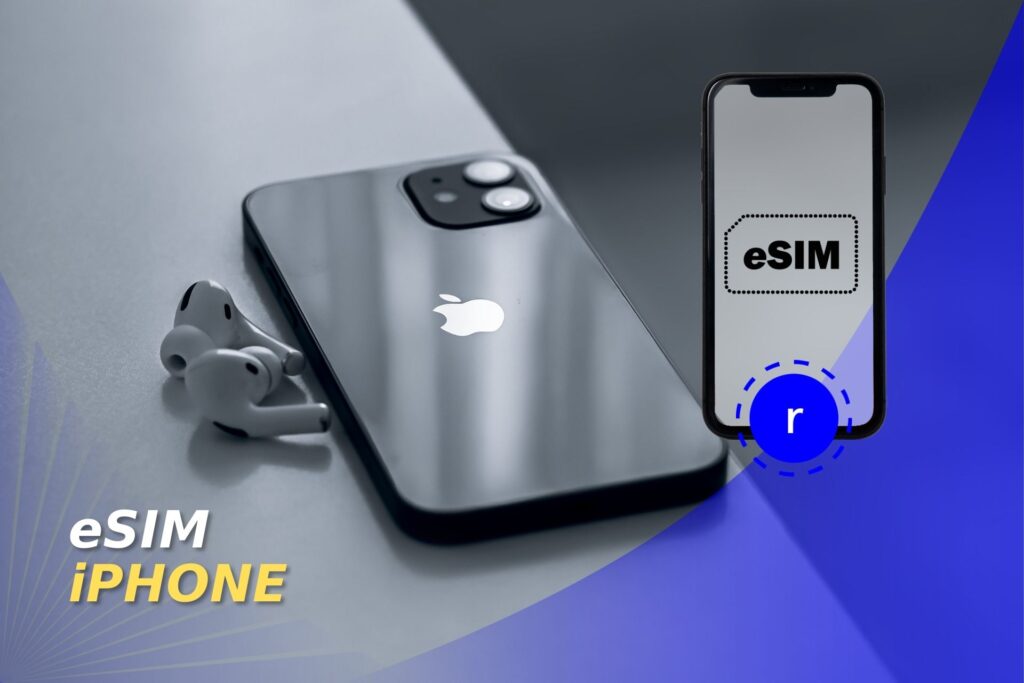If your next travel destination is Lithuania, don't hesitate to stay connected to the internet with ...
eSIM Cards
Most newer iPhones from the XS and later are eSIM-compatible, and models in some regions are eSIM-only, but how do you use the eSIM function on your iPhone?


eSIMs (embedded SIMs) have become a game-changer for mobile connectivity, allowing users to activate a cellular plan without needing a physical SIM card. Most modern smartphones work with this technology, including iPhones.
The benefits of switching to an eSIM for your iPhone are plentiful. For one, you no longer need to deal with the hassle of swapping out physical SIM cards when traveling or switching providers. Plus, you can have multiple cellular plans on one device, which is very useful for international travelers. eSIM technology is even more secure.
In this guide, we’ll cover how to activate and set up eSIM on your iPhone, how to switch between eSIM plans, and troubleshooting tips for any issues you might encounter.
eSIM on iPhone is a digital SIM technology that allows you to activate a cellular plan without the need for a physical SIM card. Unlike traditional SIM cards that you physically insert into the device, an eSIM is embedded directly into your iPhone’s hardware. This means you can activate and switch between different carriers and mobile plans from your phone’s settings, all without needing to ever insert or remove a physical SIM card.
It’s ideal for those who want to keep both personal and work number on one device, or frequent travelers who want to use a local plan while keeping their home number active.
eSIMs work by using a built-in chip that allows you to store and manage mobile network profiles digitally. Instead of inserting a physical SIM card into the device, you activate your carrier’s plan through your iPhone’s settings. When you set up eSIM on your iPhone, it downloads the carrier’s profile, which contains all the necessary information for connecting to the mobile network.
The process is simple. You can either scan a QR code provided by your carrier or manually enter the details in your iPhone settings. Once activated, you can use the eSIM just like a physical SIM card, with the added benefits of flexibility–switching between different mobile plans or activating a new plan while traveling abroad. Plus, many carriers now support eSIM for voice and data services, allowing for a seamless experience.
Most recent iPhone models support eSIM, but you should always check if your specific model is compatible. Here’s a list of eSIM-compatible iPhones:
The iPhone 14 and newer are eSIM-only if purchased in the United States, which means they don’t have a physical SIM card tray at all.
You can also manually check if your phone is compatible with eSIM by following these steps:
Getting an eSIM for your iPhone is a simple process. Here’s a quick overview of how to get an eSIM online:
If you’re buying a new iPhone in the US, you may be able to purchase it through the carrier. Since these phones don’t have a physical SIM card tray, your new iPhone will come with an eSIM.
Setting up an eSIM on your iPhone is a straightforward process. Here’s a step-by-step guide:
After you’ve activated your eSIM, you don’t need to do anything else. You can simply use your phone as normal.
Most carriers have an app that allows you to track your data usage and expenses. It’s worth downloading this to make sure you’re on top of your data.
You can add more data at any time through your provider’s app or website. All you need to do is open the app, select the plan you want to add data to, then choose the data plan or top-up option you want to use. Complete the payment process, and your data will be added to your eSIM plan.
Sometimes, there may be issues with your eSIM, such as not being able to connect to the network. Try these steps:
Or, if you want to delete your eSIM entirely, you can easily remove it from your phone. Make sure you follow your provider’s steps so that you don’t continue to be charged.
If your iPhone has a dual SIM setup, you can toggle between the plans on your phone. Depending on the model, this may be one physical SIM and one eSIM, or two eSIMs. You can use this to separate work and personal calls, or if you’re traveling internationally and want to switch to a local eSIM while also keeping your home number active.
You can set it up like this:
You can also set one line as the default and use the second line as needed.
Yes, an eSIM is generally better than a physical SIM because it’s both more secure and more flexible. eSIM technology offers several advantages over traditional physical SIM cards. While both serve the same purpose, eSIMs have clear benefits. Here’s a quick comparison:
| Feature | eSIM | Physical SIM |
| Convenience | No need to swap SIM cards, activation done digitally | Requires physical swapping for changing carriers |
| Space-saving | No SIM slot required, more space for battery or features | Takes up physical space inside the phone |
| Switching carriers | Seamless switching, no physical card needed | Requires manual SIM card replacement |
| Dual SIM support | Supports dual SIM | Not applicable; only one physical SIM |
| Profiles/Multiple lines | Can store multiple carrier profiles | Only one SIM card can be used at a time |
| International Travel | Easier to switch to local data plans without removing a SIM | You need to swap SIM cards for local networks |
Essentially, eSIMs and physical SIMs may serve the same purpose, but eSIMs offer more flexibility, convenience, and are better suited for modern smartphones, especially for frequent travelers.
You can store up to 8 eSIMs on your iPhone, but only 2 eSIMs can be active at the same time. Apple’s iPhones, starting from the XS, support multiple eSIM profiles. But only two lines can be active simultaneously–one on the physical SIM slot and one on the eSIM.
Meanwhile, you can store additional eSIM profiles on the iPhone, but you will not be able to use them unless you turn off an active line.
eSIM technology opens up a wide range of possibilities, making it more convenient and flexible for users.
While eSIM technology has many benefits, it also has some disadvantages.
| Pros | Cons |
| Dual SIM functionality: Use both a physical SIM card and an eSIM at the same time.No need for a physical SIM: More convenient for users, and there’s no risk of losing or damaging a SIM.Quick switching: Change carriers or plans quickly and easily, without changing a physical SIM.More space: Since eSIMs are integrated into the hardware, there’s more space for other features or better battery efficiency.Travel-friendly: Activate a local plan while traveling internationally, avoiding expensive roaming fees.Environmental impact: Less plastic waste because there’s no physical card. | Not all carriers support it: While eSIM adoption is growing, not all carriers offer eSIM support.Limited compatibility: eSIMs are only available on newer iPhone models.Manual activation: Some users may find the process of setting up and activating an eSIM challenging.Dependence on internet access: Since eSIM requires an internet connection to activate, you may face difficulties when setting up if you don’t have access to WiFi. |
When choosing an eSIM provider for your iPhone, it’s important to consider factors like pricing and coverage. Here are some of the top providers:
There are also local carriers in many countries, including the USA and UK, offering eSIM plans, so it’s worth exploring the options.
Here are a few things to keep in mind to make the most out of your iPhone eSIM experience:
Keep your eSIM secure: Avoid sharing your QR codes and profiles with others.

